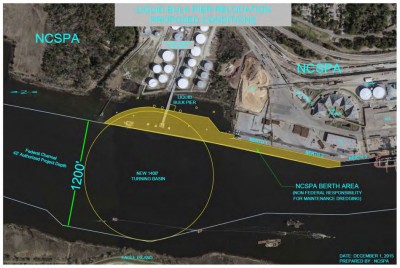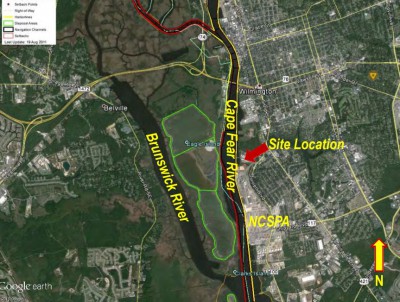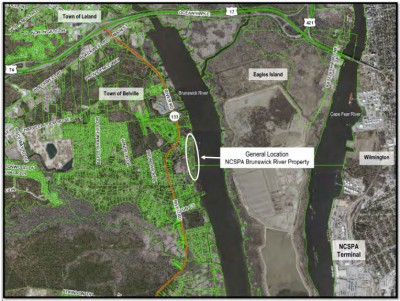WILMINGTON — State ports officials may now proceed with a $16 million dredging project to enlarge the existing ships’ turning basin to accommodate larger container vessels.
The N.C. Ports Authority received a variance Tuesday from the N.C. Coastal Resources Commission to dredge a primary nursery area in the Cape Fear River. The variance was granted by way of four separate unanimous votes during a teleconference meeting that also included authority officials and legal representatives from the state attorney general’s office.
Supporter Spotlight

The 6.4-acre project site is already developed as an industrial facility servicing oceangoing vessels but the proposed dredging is in an area the N.C. Marine Fisheries Commission has designated as a primary nursery area, or PNA, for shellfish. PNAs in this part of the Cape Fear River are defined as all areas between the banks except for the federally maintained shipping channel.
The estimated five-month project is needed so Wilmington, the state’s only container shipping port, can handle a new, larger class of container ships known as New Panamax ships up to 1,200 feet in length and 160 feet in width. The New Panamax designation is related to an ongoing expansion of the Panama Canal’s lock system that, once completed in 2016, will allow ships larger than the current Panamax ships, which are limited to 965 feet in length.
Wilmington has served ships carrying container cargo for more than 30 years and has served vessels in the Panamax class for more than 10 years.
The present 1,200-foot diameter turning basin is the only physical impediment to servicing vessels in the New Panamax class here, port officials said. Current port customers said they plan to use New Panamax ships and that they would take their business to other ports if Wilmington could not accommodate them.
The Wilmington port’s annual revenue is about $43.8 million. Container business makes up about 32 percent of the port’s revenue.
Supporter Spotlight
The Wilmington port is about 25 miles north of the river’s mouth and 1.2 miles south of the Cape Fear Memorial Bridge.

While the dredging site is designated as a PNA, the fisheries value of the area had been “somewhat reduced” due to the long history of port activity at the site, said Christine Goeble, the Division of Coastal Management’s staff attorney with the N.C. attorney general’s office.
The project involves removing with a clamshell dredge about 100,000 cubic yards of material, a reduction from the 300,000 cubic yards initially estimated. The dredge spoils are to be placed on Eagle Island, just to the west of the turning basin.
Division officials said they received no public objection to the project after the required notice was advertised. The N.C. Department of Natural and Cultural Resources advised caution during the dredging in case historic shipwreck remains were found. The N.C. Wildlife Resources Commission had raised concerns about PNA habitat but other agencies had either “no objection” or “no comment” on the project.
There are no known areas of submerged aquatic vegetation or oyster beds within the project area.
The authority submitted its original application on Oct. 16 for a Coastal Area Management Act, or CAMA, major permit, seeking approval to expand the turning basin by 200 feet, from an existing diameter of 1,200 feet to 1,400 feet, by dredging the bottom of the river. The proposed project is considered a major modification to CAMA Major Permit originally issued in 1987 for dredging of shipping berths.
The division denied the permit application on Nov. 30, based on the rule that requires new dredging projects must avoid primary nursery areas. The authority filed for a variance on Dec. 1, along with a request to expedite the hearing on the matter.

Ports officials offered two mitigation measures to offset potential effects associated with the project. A conservation easement will be conveyed to the N.C. Department of Environmental Quality for a 13.4-acre tract the authority owns on the Brunswick River that is mostly coastal marsh within primary fisheries nursery habitat. The authority will also contribute $750,000 toward a project to create a fish passage at Lock and Dam No. 2 farther up the Cape Fear River in Bladen County. The fish passage, when completed in 2017, will allow migratory species such as shortnose and Atlantic sturgeon, striped bass, American shad and river herring to access about 20-40 percent of the remaining historic fish habitat that is currently blocked.
Commission chairman Frank Gorham said the mitigation measures were beyond the commission’s authority and not considered in the action.
The board’s votes affirmed staff positions that the strict application of CAMA rules caused a hardship for the port; the hardship results from conditions peculiar to the property; the hardships were not the result of the authority’s actions; and that the variance would be consistent with the spirit, purpose and intent of the rules.







